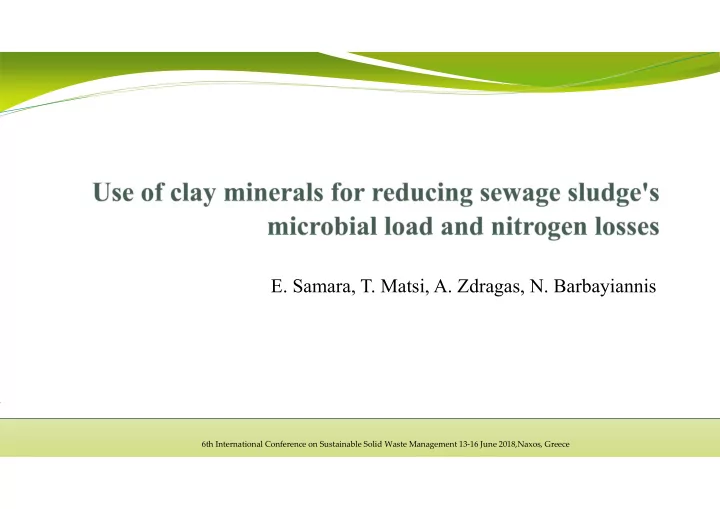

E. Samara, T. Matsi, A. Zdragas, N. Barbayiannis 6th International Conference on Sustainable Solid Waste Management 13 ‐ 16 June 2018,Naxos, Greece
Introduction Land application of sewage sludge Improves soil fertility (N, P, organic mater, micronutrients) Reduces dependence on chemical fertilizers Enriches the global goal of sustainability Most common methods: N losses (NH 3 ) during stabilization period Retention could possibly be achieved with certain clay minerals due to: Structure Strong colloidal properties Volume increase 6th International Conference on Sustainable Solid Waste Management 13 ‐ 16 June 2018,Naxos, Greece
Objectives The ability of clay minerals to: Reduce sludge’s microbial load indicators Retain sludge’s N during the stabilization process In comparison to: Untreated Limed sludge 6th International Conference on Sustainable Solid Waste Management 13 ‐ 16 June 2018,Naxos, Greece
Materials and Methods Certain properties of the clay minerals Mineral pH (cmol c kg ‐ 1 ) Mineral CEC pH CEC (cmol c kg ‐ 1 ) (1:10 H 2 O) (1:10 H 2 O) Bentonite low grade ( B1 ) 7.9 102 Saponite ( S ) 8.6 60.9 Bentonite high grade ( B2 ) 9.5 96.5 Attapulgite ( A ) 8.3 71.3 Bentonite low grade 10.5 97.4 Mixed clay of 8.5 80.0 treated with Na 2 CO 3 ( B3 ) saponite-attapulgite ( SA ) Bentonite high grade 10.1 96.5 Thermally modified 7.6 81.7 treated with Na 2 CO 3 ( B4 ) attapulgite ( ThA ) Zeolite ( Z ) 8.9 159 6th International Conference on Sustainable Solid Waste Management 13 ‐ 16 June 2018,Naxos, Greece
Certain properties of the dewatered sewage sludge Total coliform E. coli Enterococcus Salmonella spp. (MPN g -1 ) (MPN g -1 ) (MPN g -1 ) (per 25 g) 3.5 10 4 2.9 10 4 3.4 10 4 Detectable pH Dry matter LOI NO 3 -N NH 4 -N (g kg -1 ) (g kg -1 ) (mg kg -1 ) (mg kg -1 ) (1:5 H 2 O) 8.1 162 656 66.5 715 6th International Conference on Sustainable Solid Waste Management 13 ‐ 16 June 2018,Naxos, Greece
Treatments 9 minerals rates 0 (control), 10, 20 and 30% Ca(OH) 2 (RG) Experiment Plastic pots Equilibration period 70 days 2 samplings (35 and 70 days) Experimental design CRD, 3 replications ANOVA for each parameter, within each sampling (10 materials x 4 rates) & LSD test p ≤ 0.05 6th International Conference on Sustainable Solid Waste Management 13 ‐ 16 June 2018,Naxos, Greece
6th International Conference on Sustainable Solid Waste Management 13 ‐ 16 June 2018,Naxos, Greece
Results and discussion Sludge’s microbial indicators ↓ Reduction trend after 35 and 70 days Reduction of the fecal indicators (in logarithmic scale) and salmonella spp. of the 30% treatments in respect to the dewatered sewage sludge Microbial load Material B1 B2 A SA Z T. colifrom 1.8 1.1 2.4 2.8 2.5 80-100% 2.0 1.0 2.1 1.7 1.4 E. coli Enterococcus 1.4 1.3 0.7 2.1 1.9 Salmonella spp. ND ND ND ND ND The fecal indicators were ND in all treatments of Ca(OH) 2 6th International Conference on Sustainable Solid Waste Management 13 ‐ 16 June 2018,Naxos, Greece
Moisture ↓ Reduced in all treatments (7-14%) ↓ Significantly lowest in Ca(OH) 2 treatments (5-8%) pH Similar results in both samplings ↓ Control treatments’ pH decreased to acidic levels (6.3-6.6) ↑ All materials increased significantly pH Β 1, Β 2, S, Α , SA, ThA, Z: slightly acidic to slightly alkaline range (6.7-7.2) B3, B4 : alkaline to strongly alkaline range (7.5-8.8) RG10 : strongly alkaline range (12.2-12.6) 6th International Conference on Sustainable Solid Waste Management 13 ‐ 16 June 2018,Naxos, Greece
Organic matter Almost similar results in both samplings ↓ Decreased with the addition of all materials No proportional decrease to the increase of the addition rate Organic matter (as LOI %) of 30 % treatments, after 70 days of equilibration Rate Material Highest OM B1 B2 B3 B4 S content 30 % 20.9mn 20.7mn 20.6mn 20.3mn 28.7ij A SA ThA Z RG Lowest OM 30 % 27.8jkl 23.9klm 23.5lm 24.2klm 1.6o content 6th International Conference on Sustainable Solid Waste Management 13 ‐ 16 June 2018,Naxos, Greece
NO 3 -N At 30% rate : Significantly lowest concentration of each material NO 3 -N (mg kg -1 ) of all treatments at 30 % rate, after 70 days of equilibration Rate Material B1 B2 B3 B4 S Lowest NO 3 -N 30 % content 925lmn 802mno 166r 145r 776no A SA ThA Z RG Highest NO 3 -N 30 % content 1417cd 861mno 842mno 975klm 496q Within each rate lowest concentration: B3, B4, RG 6th International Conference on Sustainable Solid Waste Management 13 ‐ 16 June 2018,Naxos, Greece
NH 4 -N Highest concentration: Z All rates Lowest concentration: RG At 30% the rest minerals had similar content C/N ratio ↑ Increase with the increase of rate (except Z) Ranged at low levels (5.3-8.4) even the control (6.8-7.0) 6th International Conference on Sustainable Solid Waste Management 13 ‐ 16 June 2018,Naxos, Greece
Conclusions Natural bentonite Attapulgite Promising materials for Mixed clay of saponite-attapulgite sewage sludge sanitation Zeolite They preserve more sludge’s N Economic materials found in Greece Could be an alternative way to treat sludge 6th International Conference on Sustainable Solid Waste Management 13 ‐ 16 June 2018,Naxos, Greece
Thank you for your attention 6th International Conference on Sustainable Solid Waste Management 13 ‐ 16 June 2018,Naxos, Greece
Recommend
More recommend